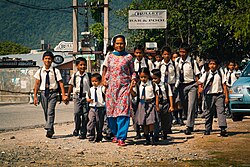Education in Nepal was long based on Home schooling and Gurukula.[1] The first formal school was established in 1853 but was intended to the elites. The birth of the Nepalese democracy in 1951 opened the classrooms to a more diverse population.[1]
The education plan in 1971 fastened the development of Education in the country:[1] In 1951, Nepal had 10 000 students divided in 300 schools, with an adult literacy rate of 5%.[1] By 2010, the adult literacy rate had jumped to 60.3% (female: 46.3%, male: 73%)[2]and the number of schools to 49 000.[1] Poverty and social exclusion of women, lower caste,indigenous people are nowadays the main constraints to an equitable access to Education.[1]
Contents
[hide]Administration[edit]
The Ministry of Education is the apex body responsible for initiating and managing education activities in the country. The Minister of Education, assisted by the State/Assistant Minister, provides political leadership to the Ministry. The Ministry, as a part of the government bureaucracy, is headed by the Secretary of Education and consists of the central office, various functional offices, and offices located at the regional and district levels. The Central Office or the Ministry is mainly responsible for policy development, planning and monitoring, and evaluation regarding different aspects of education.
With a purpose of bringing education administration nearer to the people, the Ministry has established five Regional Directorates and 75 District Education Offices in five development regions and 75 districts respectively. These decentralized offices are responsible for overseeing nonformal and school-level education activities in their respective areas. Regional Directorates are mainly responsible for coordinating and monitoring and evaluation of education activities and the District Education Offices are the main implementing agencies.
The National Center for Educational Development (NCED) [3] is an apex body for teacher training in Nepal. There are 34 Educational Training Centers (ETCs) under NCED to support the teachers in pedagogical areas.
Legally, there are two types of school in the country: community and institutional. Community schools receive regular government grants whereas institutional schools are funded by school's own or other non-governmental sources. Institutional schools are organized either as a non-profit trust or as a company. However, in practical terms, schools are mainly of two types: public (community) and private (institutional).
A third type of school is the kind run by the local people enthusiastic toward having a school in their locality. They do not receive regular government grants and most of them do not have any other sustainable financial source. Supported and managed by the local people, they can be thus identified as the real community schools.
Except one, all universities/academies are publicly managed and are supported by public source fund. However, public universities also provide affiliation to private colleges. Two academies of higher education are single college institutes whereas other universities have constituent and affiliated colleges across the country.*
Structure[edit]
Education in Nepal is structured as school education and higher education. School education includes primary level of grades 1–5, lower secondary and secondary levels of grades 6–8 and 9–10 respectively. Pre-primary level of education is available in some areas. Six years old is the prescribed age for admission into grade one. A national level School Leaving Certificate (SLC) examination is conducted at the end of grade 10.
Grades 11 and 12 are considered as higher secondary level. Higher Secondary Education Board (HSEB) supervises higher secondary schools which are mostly under private management. Previously these grades were under the university system and were run as proficiency certificate level. Though some universities still offer these programs, the policy now is to integrate these grades into the school system.
Higher education consists of bachelor, masters, and PhD levels. Depending upon the stream and subject, bachelors level may be of three to five years' duration. The duration of masters level is generally two years. Some universities offer programs like M Phil and post-graduate diplomas.
Vocational education in Nepal starts after lower secondary education. Students can choose to follow a two year curriculum leading to the "Technical School leaving Certificate".[4]Universities also offers professional and technical degrees. Out of the formal track, short-term programs(1 year) focusing on skills development are also available.[4


No comments:
Post a Comment